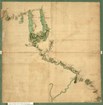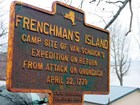Although the fort is most famous for it's role in the Siege of 1777, numerous other battles and events happened near and in conjunction with the soldiers of Fort Schuyler.
-
Fort Stanwix National Monument
Article 1: The Key to the Continent: Early Military History of the Oneida Carry

For centuries the Haudenosaunee people, including the Oneida Indian Nation, utilized a narrow strip of land situated between the Mohawk River and Wood Creek. It is here where the waters of the Mohawk flow east to Albany, the Hudson River, and New York City while those of Wood Creek flow west to Oneida Lake, Oswego, and Lake Ontario. The Oneida Carry was a land portage two to four miles wide that people could carry their canoes between the two waterways with relative ease. Read more
-
Article 2: Burgoyne's Campaign: June-October 1777

A plan to divide the Colonies was put into action by the British in 1777. The results of the "Campaign of 1777" went on to change the course of the conflict and helped the fledgling United States to a larger victory. Read more
-
Fort Stanwix National Monument
Article 3: The 1777 Siege of Fort Schuyler

The siege of the fort began officially on August 3, 1777 when the British sent their first surrender demands to the fort, and would continue through the next 21 days. An advanced party of the British force had arrived on August 2, in an attempt to intercept supplies heading for the fort. Read more
-
Fort Stanwix National Monument
Article 4: Here’s to the Red, White, & Blue!!!

Did you know it was once believed that the American flag first flew over the walls of Fort Stanwix/Schuyler? For years, compelling evidence led many to this conclusion. It was even written in history books! However, the evidence compiled over the years has disproved this idea. But the origins of it remain an intriguing mystery! Read more
-
Fort Stanwix National Monument
Article 5: The Battle at Oriska

The Battle of Oriskany occurred on August 6, 1777, when the local Tryon County Militia attempted to come to the relief of the besieged Fort Schuyler (Stanwix). On July 30, 1777, the militia's commander, General Nicholas Herkimer, had ordered his men to begin assembling at Fort Dayton (located in the modern Herkimer area). Read more
-
Fort Stanwix National Monument
Article 6: Lieutenant Colonel Willett's Sortie

August 6, 1777 was a fateful day during the Siege of Fort Schuyler. While relief columns were held up in battle, Lt. Colonel Marius Willett led a force from the fort in the hopes of chasing the enemy once and for all. Read more
-
Fort Stanwix National Monument
Article 7: The Clinton-Sullivan Campaign of 1779

The American destruction of the Six Nations' homelands came as a result of the destructive raids carried out by the Indians and American loyalists on the frontiers of New York and Pennsylvania in 1778. The raids crippled the American Continental Army by depriving it of food and manpower, and spread terror by destroying frontier settlements and taking prisoners. This forced the settlements to be abandoned for a time, if not indefinitely. Read more
-
Fort Stanwix National Monument
Article 8: The Van Schaick Expedition - April 1779

In January of 1779, eight neutral Onondaga chiefs decided to cast their lot with the Oneida and Tuscarora. Only the Oneida and Tuscarora Nation were recognized by the Americans as allies. The Onondaga Nation claimed their overall stance to be neutral, but in addition to the neutrals there were pro-American and pro-British factions as well. Read more
